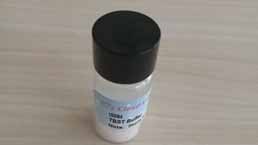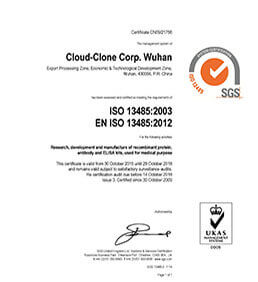Recombinant Histone H3 (H3)
- Product No.RPA285Mi01
- Organism SpeciesHomo sapiens (Human), Mus musculus (Mouse), Rattus norvegicus (Rat), Oryctolagus cuniculus (Rabbit), Rhesus monkey (Simian), Equus caballus; Equine (Horse) Same name, Different species.
- SourceProkaryotic expression
- HostE.coli
- Endotoxin Level<1.0EU per 1µg (determined by the LAL method)
- Subcellular LocationNucleus, Chromosome
- Predicted Molecular Mass16.9kDa
- Accurate Molecular Mass18kDa(Analysis of differences refer to the manual)
- Residues & TagsMet1~Ala136 with N-terminal His Tag
- Buffer FormulationPBS, pH7.4, containing 0.01% SKL, 5% Trehalose.
- Traits Freeze-dried powder
- Purity> 90%
- Isoelectric Point11.0
-
Applications
Positive Control; Immunogen; SDS-PAGE; WB.
If bio-activity of the protein is needed, please check active protein. - DownloadInstruction Manual
- UOM 10µg50µg 200µg 1mg 5mg
- FOB
US$ 160
US$ 400
US$ 800
US$ 2400
US$ 6000
For more details, please contact local distributors!
SEQUENCE

USAGE
Reconstitute in 10mM PBS (pH7.4) to a concentration of 0.1-1.0 mg/mL. Do not vortex.
STORAGE
Avoid repeated freeze/thaw cycles. Store at 2-8°C for one month. Aliquot and store at -80°C for 12 months.
STABILITY
The thermal stability is described by the loss rate. The loss rate was determined by accelerated thermal degradation test, that is, incubate the protein at 37°C for 48h, and no obvious degradation and precipitation were observed. The loss rate is less than 5% within the expiration date under appropriate storage condition.
GIVEAWAYS
INCREMENT SERVICES
-
 BCA Protein Quantification Kit
BCA Protein Quantification Kit
-
 Molecular Mass Marker for Protein
Molecular Mass Marker for Protein
-
 Monoclonal Antibody Customized Service
Monoclonal Antibody Customized Service
-
 Polyclonal Antibody Customized Service
Polyclonal Antibody Customized Service
-
 Protein Activity Test Experiment Service
Protein Activity Test Experiment Service
-
 Immunoprecipitation (IP) Experiment Service
Immunoprecipitation (IP) Experiment Service
-
 TBST Buffer
TBST Buffer
-
 TBS Buffer
TBS Buffer
-
 TRIS Buffer
TRIS Buffer
-
 Spike RBD Protein (S-RBD)
Spike RBD Protein (S-RBD)
-
 Protein G
Protein G
-
 Protein A
Protein A
| Magazine | Citations |
| Biomed Res Int | A Novel Anti-Histone H1 Monoclonal Antibody, SSV Monoclonal Antibody, Improves Lung Injury and Survival in a Mouse Model of Lipopolysaccharide-Induced Sepsis-Like Syndrome PubMed: 25649890 |
| Cell Death & Disease | Proteomic analysis reveals USP7 as a novel regulator of palmitic acid-induced hepatocellular carcinoma cell death Pubmed:35732625 |
| Catalog No. | Related products for research use of Homo sapiens (Human), Mus musculus (Mouse), Rattus norvegicus (Rat), Oryctolagus cuniculus (Rabbit), Rhesus monkey (Simian), Equus caballus; Equine (Horse) Organism species | Applications (RESEARCH USE ONLY!) |
| RPA285Mi01 | Recombinant Histone H3 (H3) | Positive Control; Immunogen; SDS-PAGE; WB. |
| CAA285Mi01 | Anti-Histone H3 (H3) Polyclonal Antibody | Loading Control of WB. |
| PAA285Mi01 | Polyclonal Antibody to Histone H3 (H3) | WB; IHC; ICC; IP. |
| MAA285Mi21 | Monoclonal Antibody to Histone H3 (H3) | WB; IHC; ICC; IP. |
| MAA285Mi22 | Monoclonal Antibody to Histone H3 (H3) | WB |
| MAA285Mi23 | Monoclonal Antibody to Histone H3 (H3) | WB; IHC; ICC; IP. |
| MAA285Mi24 | Monoclonal Antibody to Histone H3 (H3) | WB; IHC; ICC; IP. |
| SEA285Mi | ELISA Kit for Histone H3 (H3) | Enzyme-linked immunosorbent assay for Antigen Detection. |
| LMA285Mi | Multiplex Assay Kit for Histone H3 (H3) ,etc. by FLIA (Flow Luminescence Immunoassay) | FLIA Kit for Antigen Detection. |








